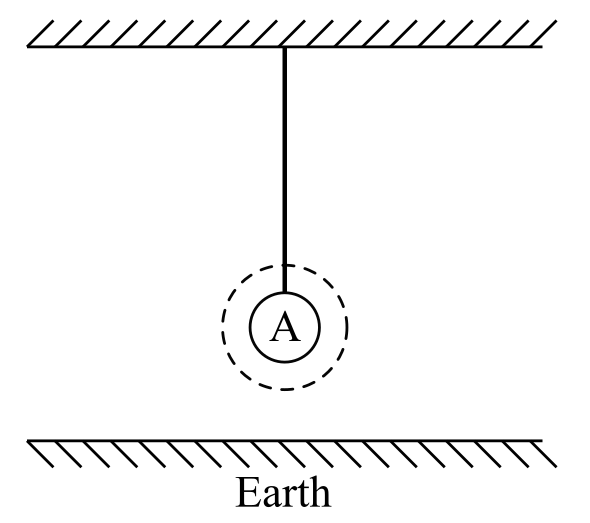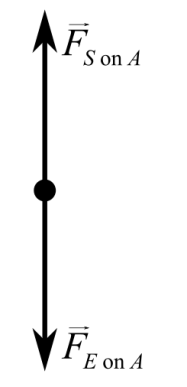
Concept explainers
Review Question 3.1 How do we determine how many forces to draw on a force diagram?
The way in which one can draw the forces in a force diagram.
Answer to Problem 1RQ
Solution:
The number of forces in the force diagram must be equal to the number of objects it is interacting with.
Explanation of Solution
Introduction:
Force is a vector quantity and it can be contacting as well as noncontacting in nature.
Explanation:
Consider a ball

Considering ball as the system, there are two forces acting on it, as follows:
The string will apply an upward force of contacting nature:
The earth will apply a downward force of noncontacting nature:
The force diagram for the system of forces is as shown below:

Here, the length of the arrows indicates the magnitude of the forces, and the direction indicates the direction in which they are acting.
Conclusion:
Hence, to determine the number of forces acting on a system, consider only the number of forces acting on it from the objects it is interacting with.
Want to see more full solutions like this?
Chapter 3 Solutions
College Physics
Additional Science Textbook Solutions
Campbell Biology (11th Edition)
Chemistry: Structure and Properties (2nd Edition)
Genetic Analysis: An Integrated Approach (3rd Edition)
Cosmic Perspective Fundamentals
Anatomy & Physiology (6th Edition)
Human Physiology: An Integrated Approach (8th Edition)
- A capacitor with a capacitance of C = 5.95×10−5 F is charged by connecting it to a 12.5 −V battery. The capacitor is then disconnected from the battery and connected across an inductor with an inductance of L = 1.55 H . At the time 2.35×10−2 s after the connection to the inductor is made, what is the current in the inductor? At that time, how much electrical energy is stored in the inductor?arrow_forwardCan someone help me with this question. Thanks.arrow_forwardCan someone help me with this question. Thanks.arrow_forward
 Principles of Physics: A Calculus-Based TextPhysicsISBN:9781133104261Author:Raymond A. Serway, John W. JewettPublisher:Cengage Learning
Principles of Physics: A Calculus-Based TextPhysicsISBN:9781133104261Author:Raymond A. Serway, John W. JewettPublisher:Cengage Learning College PhysicsPhysicsISBN:9781305952300Author:Raymond A. Serway, Chris VuillePublisher:Cengage Learning
College PhysicsPhysicsISBN:9781305952300Author:Raymond A. Serway, Chris VuillePublisher:Cengage Learning College PhysicsPhysicsISBN:9781285737027Author:Raymond A. Serway, Chris VuillePublisher:Cengage Learning
College PhysicsPhysicsISBN:9781285737027Author:Raymond A. Serway, Chris VuillePublisher:Cengage Learning Physics for Scientists and Engineers: Foundations...PhysicsISBN:9781133939146Author:Katz, Debora M.Publisher:Cengage Learning
Physics for Scientists and Engineers: Foundations...PhysicsISBN:9781133939146Author:Katz, Debora M.Publisher:Cengage Learning Physics for Scientists and Engineers, Technology ...PhysicsISBN:9781305116399Author:Raymond A. Serway, John W. JewettPublisher:Cengage Learning
Physics for Scientists and Engineers, Technology ...PhysicsISBN:9781305116399Author:Raymond A. Serway, John W. JewettPublisher:Cengage Learning Physics for Scientists and EngineersPhysicsISBN:9781337553278Author:Raymond A. Serway, John W. JewettPublisher:Cengage Learning
Physics for Scientists and EngineersPhysicsISBN:9781337553278Author:Raymond A. Serway, John W. JewettPublisher:Cengage Learning





